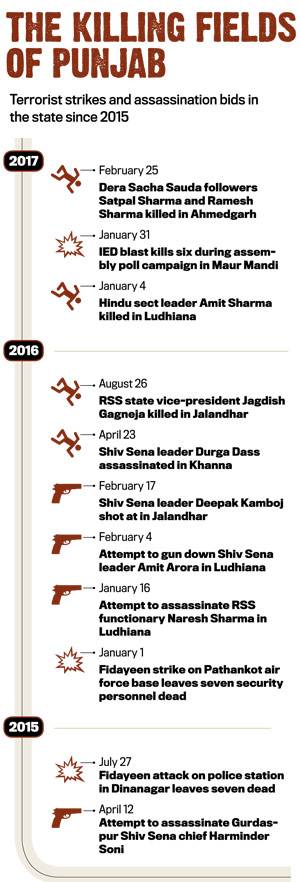Punjab: Crime
This is a collection of articles archived for the excellence of their content. |
Contents |
Punjab: Sectarian violence
India Today June 8, 2009
Arvind Chhabra
In the name of religion
It doesn’t take a lot to rouse communal passions in the country. Even prosperous and seemingly peaceful Punjab erupted in caste violence overnight. Days of violence, following the fatal attack on Dera Sach Khand Ballan leaders in Vienna took the lives of three people. Scores of vehicles and trains were torched and public property worth crores was damaged. Curfew was imposed and despite the massive security forces, and appeals by Dera leaders, it took days to restore normalcy. Though many are baffled over the scale of violence that erupted, people here have not been taken by surprise. “It is understandable, a spontaneous outburst,” said Chief Minister Parkash Singh Badal, as the violence erupted within hours of the attack on Sant Niranjan Dass and Sant Ramanand, leading to the death of the latter. Dera-related violence has ceased to surprise people in Punjab. Earlier, it was Sirsa-based Dera Sacha Sauda’s followers who have been part of clashes and before that it was Baba Piara Singh Bhaniarewala’s followers. But in both these cases, radical Sikhs had found “clear provocations”, while in the case of Dera Sach Khand, nothing of that sort is apparent. Situated in the village of Ballan— seven miles north of Jalandhar, on the Pathankot road—the Dera peacefully propagates the preachings of its guru, Ravidass. Actually, this is where the tiff starts—the difference in the doctrines between the Sikhs and the Ravidassias. “Dera Ballan became a paragon of the Ravidass movement in north-west India and it made concerted efforts for the construction of a separate Dalit identity, independent of both Sikhism and Hinduism,” says Ronki Ram, a political science professor who has done extensive research on the Dera. “It is in this context that Dera Ballan has emerged as an alternative religious site for the Dalits with its own code of conduct that paved the way for a separate Dalit identity,” says Ram. A Ravidass gurudwara has the idols of Guru Ravidass and the late head of Dera Ballan along with the Guru Granth Sahib. Ravidass is considered a guru and so are the gaddi nashins (heads) of the Deras. Sant Niranjan Dass is the fifth gaddi nashin at Dera Ballan. This is not acceptable to Sikhs who consider Ravidass as a “bhakta” and rever only the 10 gurus and the Guru Granth Sahib—an issue that has pitted the community and Jat Sikhs against each other. Yet the Ravidass community has grown and become assertive with Ravidass gurudwaras coming up across the world.
The Vienna incident was evidently triggered after a Ravidass gurudwara came up in 2006, causing some resentment among radical Sikhs.
“Every year maharajji had been visiting it for religious discourses. But to my knowledge there was no problem. We believe in peace and preach peace,” says the Dera Sach Khand spokesman S.R. Heer.
Sources, however, do point out to rising discontent among Sikh radicals. Yet the Deras grow, especially with political parties giving them patronage, knowing that these form formidable votebanks and annoying these could harm their political interests. That’s why when violence taking place in faraway Vienna causes Punjab to erupt, political leaders choose to term the reaction as “spontaneous”. The fault lines
• Ravidassias worship idols of Guru Ravidass and late heads of Dera Ballan along with the Guru Granth Sahib.
• Ravidass is considered a guru and so are the Dera heads.
• Their last names are Dass, perhaps taken from their guru’s name.
• Sikhs consider Ravidass as a “bhakta”. For them no living person can be a guru.
• They accept the ten gurus and the Guru Granth Sahib as their only guru.
• Sikhs in most cases keep their last name as Singh.
Origins of Dera Ballan
• Sant Pipal Dass founded it at the beginning of the 20th century when he lost his wife after which he left home with his son Sarwan Dass in search of truth.
• The saints of Ballan developed their own religious symbols, flags, prayers, dress, salutations, and rituals of worship.
• Even the architecture of Dera Ballan is unique as it resembles both a temple and a gurudwara at the same time.
• Ballan saints wear turban, keep unshorn hair and flowing beards, like Sikh priests even though one of the late heads of Dera Ballan, Sant Garib Dass, was clean-shaven.
Terrorist attacks: 1995-2015

The Times of India, July 28, 2015
Three suspected jihadi terrorists armed with AK-47 rifles went on a rampage in Punjab's border district of Gurdaspur, killing three civilians and four policemen.The terrorists, suspected to be members of either Lashkar-e-Taiba or Jaish-e-Muhammed, killed seven people before Punjab Police commandos gunned them down in an agonizing 12-hour battle. Before storming the police station, the militants had also planted five bombs on nearby rail tracks.The casualties included four policemen -three young men of the Home Guards and superintendent of police Baljit Singh -all of whom were hit while staving off relentless firing from the attackers.
2001- Jan 2016: Terror attacks in Punjab
The Times of India Jan 02 2016
Today's attack at Pathankot Indian Air Force base is the second terror strike in Punjab within a span of six months.
Following are some of the terror-related incidents that have taken place in Punjab between 2001 and 2016. These attacks do not include seizure of arms and ammunition during the period.
March 1, 2001: A 135-yard underground tunnel detected across India-Pakistan border in Punjab's Gurdaspur district.
Jan 1, 2002: Three Army personnel killed and five others injured when a group of unidentified terrorists attacks them at a firing range in Damtal, close to Punjab's border with Himachal Pradesh.
Jan 31, 2002: Two persons killed and 12 others injured in explosion in a Punjab Roadways bus at Patrana in Hoshiarpur district.
March 31, 2002: Two people are killed and 28 others injured in a bomb blast on Ferozepur-Dhanbad express train at Daroha, about 20km from Ludhiana.
Apr 28, 2006: At least eight persons are wounded in a bomb blast on a bus carrying 45 passengers at Jalandhar bus terminus.
Oct 14, 2007: Seven persons, including a 10-year old child, are killed and 40 others injured in a bomb blast in a cinema hall in Ludhiana.
July 27, 2015: Seven people, including a Punjab Police Superintendent, killed when three terrorists carry out a strike on a police station in Gurdaspur district. All three militants also killed.
Jan 2, 2016: Four terrorists and three security personnel killed when militants storm IAF base in
2015-2017
Terrorists arrested/killed , weapons , grenades , ammunition seized
Asit Jolly , Khalistan stirring “India Today” 19/6/2017

Terrorist strikes and assassinations
Asit Jolly , The killing fields “India Today” 19/6/2017

2017
Asit Jolly , The PCOCA Prognosis “India Today” May 1,2017
Punjab's top security officers are pressing the newly elected Amarinder Singh government to legislate fresh legal provisions to ensure a higher rate of conviction in organised crime cases. What they want is PCOCA, a Punjab-specific law that mimics the Maharashtra Control of Organised Crime Act (MCOCA), legislated amid considerable controversy in 1999 to tackle the Mumbai mafia and which was successively extended to Delhi and some other states.
Notably, legislation to this effect tabled by former deputy chief minister Sukhbir Badal was turned down by the then council of ministers in July 2016 and sent back to the state advocate general for revision.
The original PCOCA draft talks of holding suspects without bail for six months (180 days) and seeks to render 'confessions' made before police officers above the rank of SP (superintendent of police) admissible in a trial court. All it would require is for a DIG (deputy inspector general) or an officer of a higher rank to put down in writing why IPC (Indian Penal Code) provisions were inadequate in a particular case. In its present form, the draft act also empowers a court to permit in-camera trial and have a witness protection programme. It also wants special courts to ensure speedy trials.
But while the PCOCA proposal revives memories of controversial past instances of invoking MCOCA, including in the match-fixing allegations against cricketer S. Sreesanth, Punjab director general of police (DGP) Suresh Arora insists there is a strong case in favour of the legislation. Citing statistics, the DGP points to the abysmally low rate of conviction in cases pertaining to gangsters and crime syndicates - just 10 convictions versus 95 acquittals during the tenure of the last SAD-BJP regime.
Police officers also point to the impossible task of securing witnesses in recent cases, including in the terror bombing at Maur during the assembly poll campaign, the killing of Sacha Sauda adherents, the assassination of Punjab R S S vice-president Brig. V.P. Gagneja and the gunning down of the Namdhari matriarch Mata Chand Kaur in 2016.
Notably, even the CBI, which was handed over the investigation of the Gagneja and Chand Kaur killings, has not made much headway in the cases. Police officers point to the existence of 57 organised gangs with close to 500 members, underscoring their capacity to terrorise witnesses. Chief Minister Amarinder Singh, though, is yet to take a final call-it's hardly surprising, given the scope for abuse.